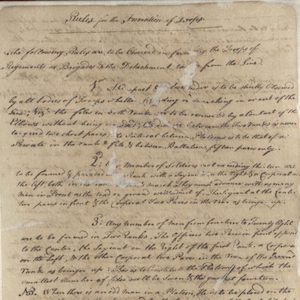About

The Continental Army Southern Department Records and Order Book is a bound volume written to keep records & orders for the Southern Department of the Continental Army. The book contains six different sections: 1. Rules for the Formation of Troops, 2. Journal of the Campaign to the Southward (General Robert Howe’s expedition into East Florida, May 9-June 14, 1778), 3. Orderly Book (August 24, 1778-May 10, 1780), 4. Proceedings of a Court of Inquiry Held at Purrysburgh (the court-martial trial of General John Ashe following the Battle of Brier Creek, March 13-16, 1779), 5. Journal of the Siege of Charles Town (March 28-May 12, 1780), and 6. Copies of Letters and Articles of Capitulation (correspondence between General Benjamin Lincoln and Sir Henry Clinton regarding the surrender of Charleston, April 10-May 11, 1780). The volume also includes charts listing the number of Continental Army officers & soldiers stationed at various locations in South Carolina, lists of Army officers and their dates of commission, resignation, and promotion, and a technical drawing of a cannon. Locations mentioned include Fort Tonyn (Fl.), Fort Morris (Ga.), Fort Moultrie, Fort Johnson, Black Swamp, Bacon’s Bridge, Thirteen Mile House, Ashley Ferry, Half-Moon Battery, and Charleston’s Horn Work. Persons referenced include General Robert Howe, Georgia Governor John Houstoun, Colonel Samuel Elbert, Lieutenant Colonel Barnard Elliott, General William Moultrie, General John Ashe, General Benjamin Lincoln, Sir Henry Clinton, and Vice Admiral Marriott Arbuthnot. A note at the front states that part of “Rules for the Formation of Troops” and the entirety of “Journal of the Campaign to the Southward” were written by John F. Grimké. The rest of the book is unattributed.
The Continental Army was organized shortly after the first encounter of the American Revolutionary War (April 19, 1775). On February 27, 1776, Congress established the Middle and Southern Departments of the Continental Army for command and administrative purposes. South Carolina troops were included in the Southern Department.
One member of the Southern Department was John F. Grimké, a resident of Charleston and Union District of South Carolina. Grimké entered the South Carolina Artillery Regiment as a lieutenant and eventually received promotions to captain and major. By November of 1778, Grimké was serving as deputy adjutant general with the rank of lieutenant colonel. Paroled by the British after the siege of Charleston, Grimké was imprisoned in March of 1781. Upon his release, Grimké joined General Nathanael Greene’s Continental Line. After the war, Grimké (an attorney trained in London) served as a judge and a member (1782-1790) and the Speaker (1785-1786) of the House of Representatives of South Carolina.
Related Terms:
- South Carolina Historical Society
Institution:
- Manuscripts
Media Types:
- Aiken County,
- Charleston County,
- Jasper County
SC Counties:
- American Revolution (1775-1783)
